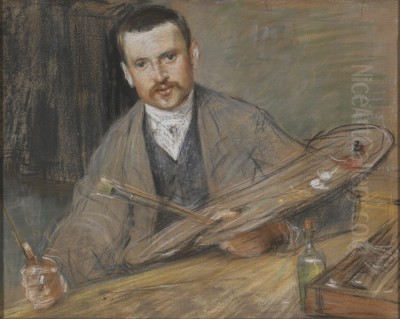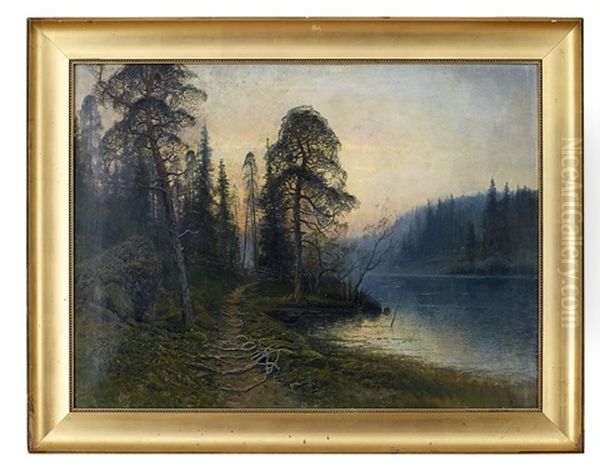
Johan Kindborg (1861–1907) stands as a significant, albeit once overlooked, figure in the rich tapestry of Swedish art history. A painter deeply connected to the natural beauty of his homeland, Kindborg dedicated his relatively short career to capturing the nuanced landscapes and atmospheric subtleties of Sweden. His work, characterized by a keen sensitivity to light, color, and mood, offers a poignant glimpse into the Nordic environment at the turn of the 20th century. Though not widely celebrated during his lifetime, subsequent generations have rediscovered his talent, securing his place as a noteworthy landscape artist whose works resonate with quiet authenticity and profound appreciation for nature.
Early Life and Artistic Formation
Born on January 30, 1861, Johan Kindborg entered a Sweden experiencing significant cultural and artistic shifts. While specific details about his earliest training remain somewhat scarce in readily available records, it is evident that he became part of the burgeoning Stockholm art scene. His formative years likely involved rigorous study, potentially at the Royal Swedish Academy of Arts or under private tutelage, aligning him with the academic traditions of the time while also exposing him to the newer currents sweeping through European art.
The late 19th century in Sweden was a dynamic period for artists. Kindborg's contemporaries included individuals who would become pillars of Swedish art. Figures like Anders Zorn, renowned for his vibrant portraits and depictions of rural life, and Bruno Liljefors, celebrated for his masterful wildlife paintings, were part of this milieu. Other notable artists emerging during this era included Richard Bergh, a key figure in the National Romantic movement, Johan Tirén, known for his Sámi motifs, and the portraitist Karl von Saltza. Kindborg developed his skills within this stimulating environment, navigating the expectations of traditional landscape painting while subtly forging his own path.
Artistic Style and Influences

Kindborg's artistic identity is firmly rooted in landscape painting. He possessed a remarkable ability to translate the specific character of the Swedish environment onto canvas. His style is marked by a dedication to realistic depiction, yet it transcends mere photographic representation. He was particularly adept at capturing the ephemeral qualities of light – the soft glow of twilight over a lake, the dappled sunlight filtering through a forest canopy, or the cool luminescence of moonlight on water.
His palette often reflects the specific Nordic light, sometimes muted and melancholic, other times clear and crisp. There's a sensitivity in his application of color, used not just to describe form but also to evoke emotion and atmosphere. While not strictly an Impressionist in the French sense, Kindborg's work sometimes shows an affinity with Impressionist principles, particularly in its focus on light effects and capturing fleeting moments in nature. This aligns him with some Swedish contemporaries who formed the "Opponents" group, reacting against the strictures of the Academy and seeking more personal, modern forms of expression, often influenced by French plein-air painting.
Kindborg's approach often involved careful observation combined with a lyrical sensibility. His landscapes feel inhabited, not just by the flora and fauna depicted, but by a palpable sense of place and mood. He masterfully balanced detailed rendering, especially in foreground elements, with broader, more atmospheric handling of skies and distant views, creating depth and inviting the viewer into the scene.
Themes and Subjects
The core of Johan Kindborg's oeuvre lies in his exploration of the Swedish landscape in its various forms. He was drawn to the ubiquitous presence of water in the Nordic environment, frequently depicting tranquil lakes, meandering rivers, and coastal scenes. These works often emphasize stillness and reflection, capturing the unique interplay of water, land, and sky. Forest interiors also feature prominently, showcasing his skill in rendering the complex patterns of light and shadow beneath the trees.
Beyond pristine nature, Kindborg also turned his attention to scenes that included human presence, though often subtly integrated. He depicted pastoral landscapes with grazing cattle, suggesting the harmonious relationship between rural life and the natural world. His paintings sometimes feature solitary figures, like a boy fishing in a small boat (eka), adding a narrative element and enhancing the sense of quiet contemplation or simple, everyday activities within the grander natural setting.
Stockholm, the city where he likely spent significant time, also appears in his work. His views of the capital, such as the depiction of Norrbro and Helgeandsholmen, demonstrate his ability to handle urban landscapes with the same sensitivity to light and atmosphere found in his nature scenes. He captured the architectural elements, the reflections in the water, and the specific urban mood, contributing to the visual record of the city during his time.
Notable Works
Several paintings stand out as representative of Johan Kindborg's artistic contributions and recurring themes:
Flödlandskap (often dated 1891): This title, translating roughly to "Flood Landscape" or "Waterscape," likely depicts a serene scene dominated by water, perhaps a river plain or lakeside area. Such works exemplify his focus on water's reflective qualities and the peaceful atmosphere of the Swedish countryside.
Försommarlandskap med metande gosse i eka (1885): Meaning "Early Summer Landscape with Fishing Boy in a Rowboat," this painting captures a quintessential Nordic summer idyll. It combines detailed landscape elements with a touch of human interest, evoking feelings of tranquility, youth, and the simple pleasures of rural life.
View of Norrbro and Helgeandsholmen, Stockholm (1892): This cityscape demonstrates Kindborg's versatility. It likely portrays the historic bridges and islands at the heart of Stockholm, focusing on architectural details, the surrounding water, and the specific light conditions of the urban environment.
Sjö i skymning (often dated 1903, though sometimes cited as 1893): Translating to "Lake at Twilight," this work is a prime example of Kindborg's skill in capturing atmospheric effects. Twilight scenes allowed him to explore subtle color transitions and the evocative mood of fading light over water, a theme he returned to.
Kor i sommargräs (often dated 1890, though sometimes cited as 1893): Meaning "Cows in Summer Grass," this painting represents his engagement with pastoral themes. It likely depicts cattle grazing peacefully in a sunlit summer meadow, celebrating the agrarian landscape and the quiet rhythms of country life.
Beyond these, works like Höllviken? II. in the Moonlight and Elegant figures on the quay at Stockholm gained attention later, particularly in the auction market, highlighting his ability to capture both moonlit mystery and sophisticated urban moments.
Contemporaries and the Swedish Art Scene
Johan Kindborg practiced his art during a vibrant period in Swedish cultural history, often referred to as the era of National Romanticism. This movement saw artists turning inward, seeking inspiration from their own country's landscapes, history, and folklore, often as a reaction against dominant continental European trends and academic conservatism. Kindborg's focus on the specific character of the Swedish landscape fits well within this broader context.
He shared the artistic stage with a generation of highly talented individuals. His fellow students at the Academy, Anders Zorn and Bruno Liljefors, achieved international renown. Richard Bergh became a leading theorist and painter associated with the National Romantic style. Others like Johan Tirén focused on specific regional cultures within Sweden.
Beyond his immediate circle of fellow students, Kindborg was contemporary with other significant Swedish landscape painters. Olof Arborelius (1842-1916) was an established figure known for his depictions of Dalarna. Axel Lindman (1848-1930) painted coastal scenes and archipelago landscapes. Alfred Thörne (1850-1916) was noted for his forest interiors and evocative moods. Johan Krouthén (1858-1932), closer in age to Kindborg, was known for his sun-drenched garden scenes and Impressionist leanings. Johan Ericson (1849-1925) specialized in coastal motifs, particularly from the west coast of Sweden. Carl Johansson (1863-1944), another contemporary, became famous for his expansive views of the Norrland wilderness, often featuring rivers and dramatic light. Prince Eugen (1865-1947), the "Painting Prince," was also a highly respected landscape painter known for his atmospheric depictions of the Stockholm region and southern Sweden.
This rich artistic environment provided both inspiration and competition. While some of these artists, like Zorn, achieved widespread fame and fortune, others, like Kindborg, pursued their vision more quietly, contributing significantly to the diversity of Swedish landscape painting at the time, even if their recognition was delayed. The period saw lively debates about style, subject matter, and the role of art in national identity, creating a fertile ground for artistic development.
Personal Life and Challenges
While Johan Kindborg's artistic legacy is centered on his sensitive landscape paintings, available information suggests his personal and professional life outside of painting may have presented challenges. Some accounts mention a period where he worked as an accountant at the Stockholm City Theatre. This role reportedly did not end well, with criticisms regarding his performance leading to a loss of popularity or standing within that context. Such difficulties in securing stable income or navigating professional environments outside of art were not uncommon for artists of the era.
Furthermore, sources hint at difficulties in his personal life, specifically mentioning marital strife with his wife, Emmy, which may have led to a breakdown of the marriage. The emotional toll of personal hardships and potential financial instability could certainly have impacted his ability to promote his work or gain the attention of influential patrons and critics during his lifetime. These biographical fragments, though sparse, add a layer of complexity to his story, suggesting a life that may have involved struggles alongside artistic dedication. It remains speculative how directly these challenges influenced his art, but they might partly explain his relative obscurity compared to some more commercially successful contemporaries.
Later Recognition and Legacy
Despite the limited recognition during his forty-six years of life, Johan Kindborg's artistic contributions did not fade into complete obscurity. Beginning in the late 20th century, a renewed interest in Nordic art from the turn of the century brought painters like Kindborg back into focus. Art historians and collectors began to appreciate the quiet mastery and authentic portrayal of the Swedish landscape inherent in his work.
His paintings started appearing more frequently in galleries and, significantly, at auction houses. Works like Sjö i skymning and Kor i sommargräs, along with others such as Höllviken? II. in the Moonlight, began to command attention and achieve respectable prices. This market interest reflected a growing acknowledgment of their artistic merit and historical value. His depictions of specific locations, like the view of Norrbro in Stockholm, also hold documentary importance, capturing the city's appearance at a particular moment in time.
Today, Johan Kindborg is recognized as a skilled and sensitive exponent of Swedish landscape painting from the late 19th and early 20th centuries. While perhaps not reaching the towering fame of Zorn or Liljefors, his work holds a secure place within the narrative of Swedish art history. He is appreciated for his technical proficiency, his nuanced understanding of light and atmosphere, and his genuine connection to the natural environment of his homeland. His rediscovery serves as a reminder that artistic value is not always immediately recognized and that significant talents can sometimes await later generations for their full appreciation.
Conclusion
Johan Kindborg's life and art offer a compelling study in quiet dedication and posthumous recognition. As a painter of the Swedish landscape, he excelled in capturing the subtle moods, the specific quality of Nordic light, and the tranquil beauty of his native environment. From serene lakes and forests to pastoral scenes and glimpses of Stockholm, his work consistently demonstrates a deep sensitivity and technical skill. Though overshadowed by more famous contemporaries during his lifetime and possibly hampered by personal challenges, the enduring quality of his art eventually led to its rediscovery. Johan Kindborg remains an important figure for understanding the breadth and depth of Swedish painting at a time of significant national and artistic identity formation, his canvases continuing to offer viewers a peaceful and evocative connection to the landscapes he knew and loved.